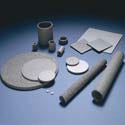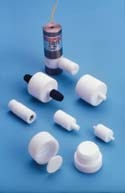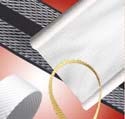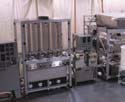Filters 14976
September 14, 2004
Originally Published MPMNSeptember 2004
SPOTLIGHT
Filters
Security filters
Defined surface characteristics and accurate mesh openings enable medical fabrics to act as security filters. Medifab products can also serve as wicking and spreading media in infusion and transfusion sets, arterial and cardiotomy blood filters, blood bags, and diagnostic test strips. The fabrics were developed to meet the processing and cleanliness requirements of the medical industry. They are routinely tested for endotoxins and hemolytic substances using USP Class VI, ISO 10993, and cytotoxicity test methods. The filters can be surface treated to enhance priming, wetting, and wicking properties.Sefar America Inc., Depew, NY www.sefar.com
Woven synthetic materials
Medical fabrics are suitable for blood filtration in arterial, cardiotomy, and transfusion applications. The precision-woven synthetics can also be used in medical and diagnostic products, such as drug-infusion systems,flow-control devices, moisture barriers, biopsy bags, and electromagnetic and radio-frequency interference shielding. The filters materials can be fabricated into slit rolls, stamped parts, tubes, pleated elements, and bags. Ultrasonic cutting and welding, pleating, and laser and cold cutting are performed in a Class 10,000 cleanroom. Customers can choose from a variety of pore sizes, thicknesses, flow rates, and hydrophilic or hydrophobic finishes.SaatiTech Inc., Somers, NY www.saati.com
Custom screens
A supplier of precision thin-metal parts offers burr-free and stress-free custom screens in a number of metal alloys. Materials include biocompatible alloys such as titanium and specialty stainless steels. According to the company, its screen production process offers low costs, fast delivery, and parts design flexibility. The tooling also enables medical device design engineers to create multiple versions of a certain part.Fotofab, Chicago, IL www.fotofab.com
Porous metal media
Filters and other porous metal products are suited for a number of medical applications requiring efficiency, exact flow specifications, biocompatibility, high-temperature resistance, and resistance to aggressive chemicals. Working with customers in the medical industry, the company has designed products meeting the filtration and flow-control requirements of medical devices. Examples include biocompatible porous titanium filters, implantable devices, metal filters in test stands, spargers used in cell-culture processes, filters to prevent plugging in catheters, and precision flow restrictors for the delivery of gases in life-critical systems. According to the company, porous metal offers the advantage of withstanding aggressive and repeated sterilization regimes.Mott Corp., Farmington, CT www.mottcorp.com
IV filter
A lightweight IV filter offers low-profile geometry for patient comfort andsmooth flow characteristics for easy priming and high-flow applications. The MediPure filter is designed for use in adult IV applications and is available in 0.2- and 1.2-µm and high-flow versions. The compact housing holds 12 cm2 of effective filtration area, and its alcohol- and lipid-resistant housing offers optic clarity even after gamma sterilization. The universal housing design can be purchased with tubing or socket ports to fit customer requirements.Filtertek, Hebron, IL www.filtertek.com
Medical electronics filters
Miniature air filters are designed to fit medical electronics equipment in which a number of certifications and classifications are critical. The line consists of air filters of 25 sq in. or smaller and thicknesses of 1¼4 in. or smaller, suitable for electronics enclosures with limited space. Frame options include flex-frame and edge-to-edge designs. With flex-frames, the products can bend to fit cramped enclosures. Edge-to-edge versions maximize the flow of clean, cooling air along the interior chassis walls. The products meet UL 94HF-1 flammability resistance requirements and can be configured with electromagnetic interference-shielding capabilities. The company delivers free prototype air filters to customers within 5 working days.Universal Air Filter, Sauget, IL www.uaf.com
In-line filter
An all-PTFE filter provides a highly inert flow path that protects laboratory equipment by trapping particulate matter. The product's housing is imprinted with a spoke-style pattern to distribute the fluid over the entire filter surface to ensure maximum productivity. Connection options are available to provide flexibility to the instrument designer, including male-female and female-female designs, plus a barbed version for 1/16-in.-ID soft-wall tubing. Designed with a replaceable element, the filter removes particulates from fluids that could otherwise damage laboratory pumps, valves, and mechanical liquid-handling devices. Unfiltered matter can create a grinding action resulting in premature wear, misalignment, deformation, fluid leakage, and equipment failure.Bio-Chem Valve Inc., Boonton, NJ www.bio-chemvalve.com
Specialty medical fabrics
With expertise in vascular grafts, orthopedic implants, and filter media, a company offers medical fabrics with high temperature resistance, static protection, UV durability, and biomedical compatibility. The products have been used in woven grafts for medical endovascular implants. All R&D, manufacturing, and material storage are carried out in dedicated environmentally controlled rooms. Complete lot traceability is maintained for a minimum of 10 years. A design staff works with customers to develop a concept, define specifications, design the fabric, create the prototype, test for performance, and support commercialization.Offray Specialty Narrow Fabrics, Chester, NJ www.osnf.com
Hollow-fiber production machines
A line of production machines are manufactured from Type 316 stainless steel and other medical-grade materials to produce fiber on a continuous basis. End uses for the fibers include the filtration of blood, water, other liquids, and gases. The company designed and built the blending kettles producing the dope that is extruded through an adjustable spinneret. The extruded fibers are deposited into a coagulation bath and conveyed through additional rinse baths. After being cleaned, they are passed through a drying oven and wound onto an autodoffing rewind. Automatic handling is also available.Chase Machine & Engineering Inc., West Warwick, RI www.chasemachine.com
Copyright ©2004 Medical Product Manufacturing News
You May Also Like

.png?width=300&auto=webp&quality=80&disable=upscale)
